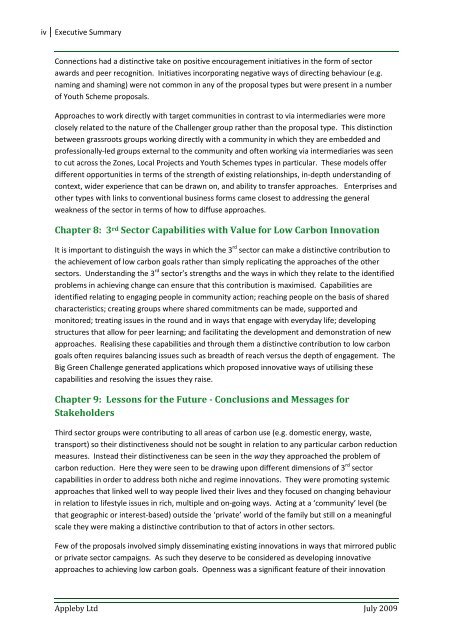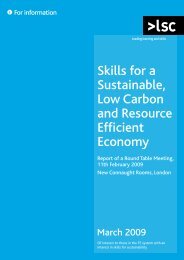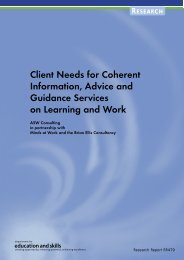Mapping the Big Green Challenge - The Skills & Learning ...
Mapping the Big Green Challenge - The Skills & Learning ...
Mapping the Big Green Challenge - The Skills & Learning ...
You also want an ePaper? Increase the reach of your titles
YUMPU automatically turns print PDFs into web optimized ePapers that Google loves.
ivExecutive SummaryConnections had a distinctive take on positive encouragement initiatives in <strong>the</strong> form of sectorawards and peer recognition. Initiatives incorporating negative ways of directing behaviour (e.g.naming and shaming) were not common in any of <strong>the</strong> proposal types but were present in a numberof Youth Scheme proposals.Approaches to work directly with target communities in contrast to via intermediaries were moreclosely related to <strong>the</strong> nature of <strong>the</strong> <strong>Challenge</strong>r group ra<strong>the</strong>r than <strong>the</strong> proposal type. This distinctionbetween grassroots groups working directly with a community in which <strong>the</strong>y are embedded andprofessionally-led groups external to <strong>the</strong> community and often working via intermediaries was seento cut across <strong>the</strong> Zones, Local Projects and Youth Schemes types in particular. <strong>The</strong>se models offerdifferent opportunities in terms of <strong>the</strong> strength of existing relationships, in-depth understanding ofcontext, wider experience that can be drawn on, and ability to transfer approaches. Enterprises ando<strong>the</strong>r types with links to conventional business forms came closest to addressing <strong>the</strong> generalweakness of <strong>the</strong> sector in terms of how to diffuse approaches.Chapter 8: 3 rd Sector Capabilities with Value for Low Carbon InnovationIt is important to distinguish <strong>the</strong> ways in which <strong>the</strong> 3 rd sector can make a distinctive contribution to<strong>the</strong> achievement of low carbon goals ra<strong>the</strong>r than simply replicating <strong>the</strong> approaches of <strong>the</strong> o<strong>the</strong>rsectors. Understanding <strong>the</strong> 3 rd sector’s strengths and <strong>the</strong> ways in which <strong>the</strong>y relate to <strong>the</strong> identifiedproblems in achieving change can ensure that this contribution is maximised. Capabilities areidentified relating to engaging people in community action; reaching people on <strong>the</strong> basis of sharedcharacteristics; creating groups where shared commitments can be made, supported andmonitored; treating issues in <strong>the</strong> round and in ways that engage with everyday life; developingstructures that allow for peer learning; and facilitating <strong>the</strong> development and demonstration of newapproaches. Realising <strong>the</strong>se capabilities and through <strong>the</strong>m a distinctive contribution to low carbongoals often requires balancing issues such as breadth of reach versus <strong>the</strong> depth of engagement. <strong>The</strong><strong>Big</strong> <strong>Green</strong> <strong>Challenge</strong> generated applications which proposed innovative ways of utilising <strong>the</strong>secapabilities and resolving <strong>the</strong> issues <strong>the</strong>y raise.Chapter 9: Lessons for <strong>the</strong> Future - Conclusions and Messages forStakeholdersThird sector groups were contributing to all areas of carbon use (e.g. domestic energy, waste,transport) so <strong>the</strong>ir distinctiveness should not be sought in relation to any particular carbon reductionmeasures. Instead <strong>the</strong>ir distinctiveness can be seen in <strong>the</strong> way <strong>the</strong>y approached <strong>the</strong> problem ofcarbon reduction. Here <strong>the</strong>y were seen to be drawing upon different dimensions of 3 rd sectorcapabilities in order to address both niche and regime innovations. <strong>The</strong>y were promoting systemicapproaches that linked well to way people lived <strong>the</strong>ir lives and <strong>the</strong>y focused on changing behaviourin relation to lifestyle issues in rich, multiple and on-going ways. Acting at a ‘community’ level (bethat geographic or interest-based) outside <strong>the</strong> ‘private’ world of <strong>the</strong> family but still on a meaningfulscale <strong>the</strong>y were making a distinctive contribution to that of actors in o<strong>the</strong>r sectors.Few of <strong>the</strong> proposals involved simply disseminating existing innovations in ways that mirrored publicor private sector campaigns. As such <strong>the</strong>y deserve to be considered as developing innovativeapproaches to achieving low carbon goals. Openness was a significant feature of <strong>the</strong>ir innovationAppleby Ltd July 2009











